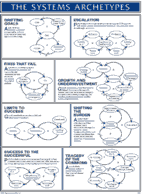 We talked in class about the general phenomena of encountering limits or constraints to growth. Any reinforcing or growth process eventually slows down. Often, there are saturation effects. For instance, in the Bass diffusion model, as the stock of adopters grows larger and larger, there’s a corresponding drop in the stock of potential adopters. Eventually, the decline in potential adopters slows down the rate of adoption, just by the simple “physics” of the adoption process.
We talked in class about the general phenomena of encountering limits or constraints to growth. Any reinforcing or growth process eventually slows down. Often, there are saturation effects. For instance, in the Bass diffusion model, as the stock of adopters grows larger and larger, there’s a corresponding drop in the stock of potential adopters. Eventually, the decline in potential adopters slows down the rate of adoption, just by the simple “physics” of the adoption process.
Other effects can slow growth. Competitors may enter a market, thereby slowing the growth of the focal firm. Consumers may demand more for their money as they become more sophisticated, and be less prone to adopt. Once they’ve made an initial purchase, consumers may become less enamored with a given product and fail to replace it when it wears out.
Limits to growth in populations
In the general case of a population (people on Easter Island or yeast in a petri dish), limits to growth occur as the level of population grows relative to the carrying capacity of the environment. Rather than adoption being the driver of growth in such cases, it’s reproduction. Net growth rates (reproduction-deaths, per time period) fall as population grows relative to carrying capacity, driven by crowding and competition for scarce resources.
In many ways, it’s a classic model; see Section 4.2 in Sterman’s Business Dynamics. Differential-equation models have been published in several literatures (e.g. ecological economics and physics) . In system dynamics, an interesting study presents and examines a model of a society that had its own cultural practices that limited population growth—helping to explain how one society avoided total collapse. Kampmann’s paper aims to replicate and explore an earlier system dynamics model, so it’s worth looking at both for the model, theory, and evidence, as well as for the methodology and approach. See Kampmann, Christian. 1991 “Replication and revision of a classic system dynamics model: Critique of population control mechanisms in a primitive agricultural society.” System Dynamics Review, 7(2): 159-198. And since we’re in this brief sidebar of discussing model critiques, let me also point you to Liz Keating’s paper Issues to Consider While Developing a System Dynamics Model –huge thanks to her and Tom Fiddaman for sharing.
Modeling limits to growth for a population requires you to consider a few things carefully. One, you want to think carefully about time constants and delays. Why would populations overshoot their carrying capacities? Why isn’t feedback instantaneous? Remember to think about the “physics” of the processes you are attempting to capture.
You’ll also need to represent the carrying capacity of the environment. Clearly, you’ve got to get the boundaries right! For instance, what’s the model boundary for the case of Easter Island (also known as Rapa Nui)? Pretty clear that it’s the island itself, right? The story, after all, is that the population grew to—and beyond—the capacity of the island’s ecosystem to support people.
But here’s an interesting question. Original settlers landed on the island in boats. Why didn’t they simply leave on boats once things began to look dire for them? From what we can tell, because the population denuded the island of trees, the material to build boats was simply unavailable. And the population pressures caused internal strife, thereby reducing islanders’ abilities to collaborate on system-level solutions to their challenges. Many of you have read Jared Diamond’s Collapse: How Societies Choose to Fail or Succeed (2005, Viking); if not, you can get the main ideas in 18 minutes via this Ted talk: http://www.ted.com/talks/jared_diamond_on_why_societies_collapse.html .
Now, it wouldn’t be science if there weren’t a controversy, and when it comes to Easter Island, one debate is about the effect of the first arrival of Europeans. The argument is that the inhabitants of the island did survive deforestation and evolved into a more egalitarian society, for a while, only to be hit by disease from European seafarers. For more on this rival explanation, see: Easter Island’s Controversial Collapse: More To The Story Than Deforestation? ScienceDaily (Feb. 18, 2009) http://www.sciencedaily.com/releases/2009/02/090218095435.htm
So, there’s debate about Easter Island, but, thanks to Diamond and others, there are plenty of other Limits to Growth cases to consider. Check out this NASA story about the fall of the Maya. The title says: “They did it to themselves.” http://science.nasa.gov/headlines/y2009/06oct_maya.htm?list1034015. (anyone wondering why NASA is interested in this issue?).







